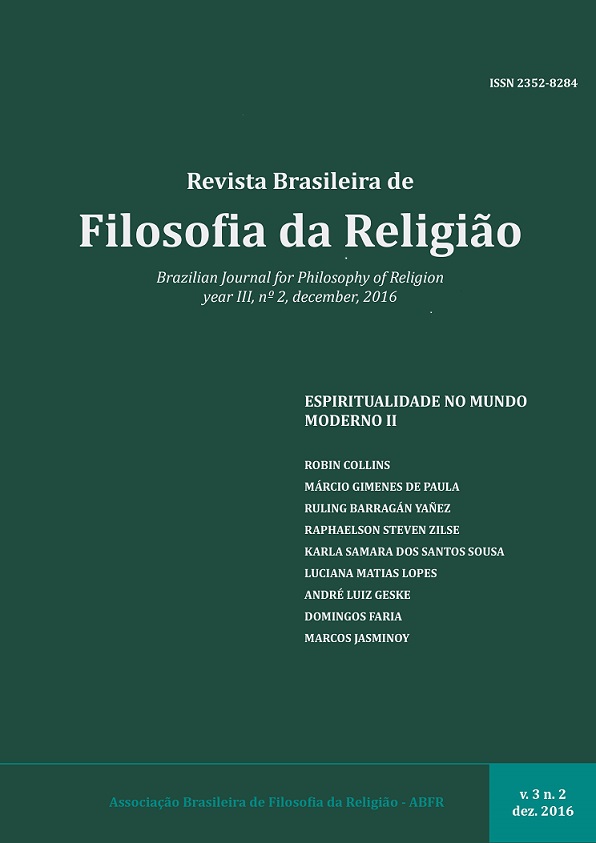TEÍSMO METODOLÓGICO
DOI:
https://doi.org/10.26512/2358-82842016e17361Palavras-chave:
naturalismo metodológico, Movimento de Design Inteligente, axiarquismo, religião e ciênciaResumo
Do modo como o defino, teísmo metodológico é a posição
segundo a qual, para os propósitos de fazer ciência (ou
investigação empírica, mais genericamente), nós
deveríamos tratar o mundo como se fosse projetado por
Deus. Uma vez que o teísmo metodológico não afirma que
Deus é uma hipótese científica, ele é compatível com o
naturalismo metodológico, que diz que deveríamos invocar
apenas entidades naturais como hipóteses científicas. Isso
constitui uma grande diferença entre o teísmo
metodológico e o assim chamado Movimento do Design
Inteligente, que rejeita o naturalismo metodológico. Eu não
apenas defendo que cientistas teístas deveriam adotar o
teísmo metodológico, mas também que este é mais fiel Ã
prática e sucesso atuais da ciência do que suas alternativas
mais importantes. Chego a essa conclusão ao olhar mais de
perto os critérios de escolha teórica na ciência. Por fim,
discuto as importantes ramificações potenciais que essa
visão pode ter sobre a prática científica e nossa visão do
mundo físico.
Downloads
Referências
CHARDIN, Teilhard, The Phenomenon of Man, Harper and Row, New York, New York, 1955.
DIRAC, P.A.M. "The evolution of the physicist's picture of nature." Scientific American, May, 1963.
HOFFMAN, Banish. Albert Einstein: Creator and Rebel, New York, New York, New American Library, pp. 17 ”“ 18, 1973.
HOGARTH, William. The Analysis of Beauty. London, UK: J. Reeves, 1753.
KLINE, Morris. Mathematical Thought, From Ancient to Modern Times, Vol. 1. Oxford, UK: Oxford University Press, 1972, p. 153.
MAUDLIN, Timothy. “Part and Whole in Quantum Mechanics”, in Elena Castellani, editor. Interpreting Bodies: Classical and Quantum Objections in Modern Physics. Princeton, NJ: Princeton University Press, 1998, 46-60.
McDERMONT, John (ed). “The Sentiment of Rationality”, in The Writings of William James. Chicago: The University of Chicago Press, 1977.
MORRIS, Simon. Life's Solution: Inevitable Humans in a Lonely Universe. Cambridge, UK: Cambridge University Press, 2003.
PAPI, F. and LUSCHI, P. “Pinpointing ‘Isla Meta’: The Case of Sea Turtles and Albatrosses,” The Journal of Experimental Biology, 199, pp. 65-71, 1996. Available on the internet at http://jeb.biologists.org/cgi/reprint/199/1/65, accessed March 15, 2009.
PENROSE, Roger. The Emperor's New Mind: Concerning Computers, Minds, and the Laws of Physics, New York: Oxford University Press, 1989.
SHELDRAKE, Rupert. The Presence of the Past: Morphic Resonance and the Habits of Nature. New York, NY: Vintage Books. 1988.
STEINER, Mark. The applicability of mathematics as a philosophical problem. Cambridge, MA, Harvard University Press, 1998.
TSIKOLIA, Nikoloz. “The role and limits of a gradient based explanation of morphogenesis: a theoretical consideration.” International Journal of Dev. Biology. 50: 333-340, 2006.
WALCOTT, Charles. 1996. “Pigeon Homing: Observations, Experiments and Confusions,” Journal of Experimental Biology, 199, 21-27, 1996. Available on the internet at http://jeb.biologists.org/cgi/reprint/199/1/21, accessed March 15, 2009.
WEINBERG, Steven. Dreams of a Final Theory. New York: Vintage Books, 1994.

